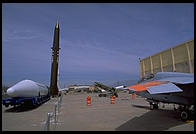
Learning to Love the Bomb
by Philip Greenspun; created 1993-1996
Home : Travel : Great Trips : Learning to Love the Bomb

by Philip Greenspun; created 1993-1996
Home : Travel : Great Trips : Learning to Love the Bomb
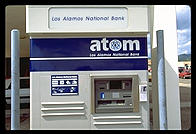 Why do Americans
demonstrate in the streets to complain that the government isn't spending enough
on AIDS research? Why do we believe that we can beat Nature with money and
brainpower. Before the Manhattan Project, it seldom occurred to anyone that
simply throwing money and brains at a scientific problem would be enough to solve
it. Science proceeded at its own pace, largely through serendipity. That the
greatest war in history could be ended by assembling a bunch of eggheads and
feeding them 2% of GNP for a couple of years gave the world faith in
government-funded science.
Why do Americans
demonstrate in the streets to complain that the government isn't spending enough
on AIDS research? Why do we believe that we can beat Nature with money and
brainpower. Before the Manhattan Project, it seldom occurred to anyone that
simply throwing money and brains at a scientific problem would be enough to solve
it. Science proceeded at its own pace, largely through serendipity. That the
greatest war in history could be ended by assembling a bunch of eggheads and
feeding them 2% of GNP for a couple of years gave the world faith in
government-funded science.
Echoes of the A-bomb project resonated through public debate during the 1950s and 60s. Nobody would have proposed going to the moon had not the Manhattan Project succeeded. Even most of our grand social projects were partly inspired by the physicists and engineers of Los Alamos. Now that viruses and cancers are humbling us, it is comforting to take a nostalgic ride back to the simpler times when the only important question was "how can we kill a lot of people with just one bomb?"
Start at the Massachusetts Institute of Technology in Cambridge. It was MIT professor Vannevar Bush who convinced Roosevelt to fund the project and it was MIT electrical engineers who built the precision timers that triggered nuclear reactions. Charles Stark Draper developed the inertial guidance system that is used in every airplane autopilot and intercontinental ballistic missile (ICBM). MIT spun off Draper Lab into the adjacent Technology Square commercial area because of antiwar protestors. You can't go inside, but note the D-with-bullseye logo on the sign outside.
Head Southwest down the Blue Ridge Parkway. Detour on I-64 to the Greenbriar Resort in White Sulphur Springs, West Virginia. Seven hundred feet underneath the famous hotel, there is an Eisenhower-era bunker built to house Congress and its staff during nuclear wars (information (800) 624-6070 x7810). Get back on the Blue Ridge to Oak Ridge, Tennessee where fissionable Uranium 235 isotopes were separated from U-238. If it seems an odd spot for a research lab, reflect that when Roosevelt went to Congress for Manhattan Project funding, a Senate committee chairman said "That sounds like a great bomb, Mr. President. Where in Tennessee are we going to build it?"
If you stop into the Department of Energy's museum in Oak Ridge, you will learn just how difficult it is to separate U-235 from U-238 because they have exactly the same chemical properties. Japanese physicists understood this as well and, analyzing the Hiroshima fallout, correctly calculated that America could not produce a bomb like this more than once every six months. Unhappily for them, Oak Ridge had a graphite reactor producing plutonium 239 for the Nagasaki bomb, a completely different technology. This reactor operated from 1944 to 1963 and is now open to tourists who want to play Homer Simpson.
At this point you can optionally detour down to Aiken, South Carolina to the Savannah River Site where bomb-grade plutonium and tritium were manufactured starting in the 1950s (book in advance, (803) 644-6817). If you really like South Carolina, folow I-20 east to Florence and then Mars Bluff. After Francis Marion College, turn right on Mars Bluff Road and proceed about a mile. This is where an Air Force B-47, en route to Germany, dropped an atomic bomb in 1958. The TNT around the nuclear material detonated, replacing Walter Gregg's farmhouse with a 35'-deep crater (now a swamp).
Proceed to Enrico Fermi's lab at the University of Chicago. Stop at the Corvette factory in Bowling Green, Kentucky (tours M-F at 9 and 1). Enrico Fermi achieved the first sustained nuclear chain reaction in a squash court underneath the football stadium. Like most of the bomb scientists, Fermi died early (at 53) and of cancer.
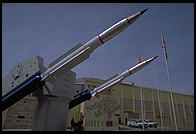 Taking care to stop at the
Cahokia Mounds in Collinsville, IL (see "Ancient Ohio"), zig southwest to
Albuquerque, New Mexico and the National Atomic Museum. Note the lovingly
displayed H-bombs, B-29, and B-52. Atomic warfare has been very very good for New
Mexico. Take the Turquoise Trail up through Madrid and Santa Fe to arrive at Los
Alamos, 90 miles to the north. This is where the A-bombs were (and are) designed.
There is an interesting bomb museum in the downtown area, a freeze-dried relic of
1957 when the city was finally opened to the public.
Taking care to stop at the
Cahokia Mounds in Collinsville, IL (see "Ancient Ohio"), zig southwest to
Albuquerque, New Mexico and the National Atomic Museum. Note the lovingly
displayed H-bombs, B-29, and B-52. Atomic warfare has been very very good for New
Mexico. Take the Turquoise Trail up through Madrid and Santa Fe to arrive at Los
Alamos, 90 miles to the north. This is where the A-bombs were (and are) designed.
There is an interesting bomb museum in the downtown area, a freeze-dried relic of
1957 when the city was finally opened to the public.
Hanging out at the Los Alamos National Laboratory isn't as difficult as it would seem. Weapons research is carried out "inside the fence", said fence being patrolled by machine-gun-toting guards. You can visit the library, eat in the cafeteria, and take a 25-mile driving tour on Department of Energy land without getting shot. The Lab borders the 13th-century Indian ruins of Bandelier National Monument.
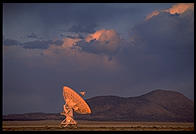
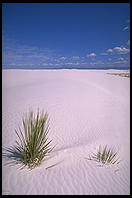 The next logical stop on the
tour is Trinity Site, south of Albuquerque in the White Sands Missile Range. Stop
west of Socorro to ponder 27 huge domes that comprise the Very Large Array radio
telescope before moving on toward Alamogordo. The Manhattan Project only produced
enough U-235 for one bomb and they were confident that it would work, so that was
reserved for Hiroshima. The plutonium bomb involved more technology risk and the
fuel was easier to obtain, so a test bomb was hoisted up a tower here and
detonated on July 16, 1945, the world's first atomic explosion. The military
enjoyed this so much that they decided to continue bombing the area. It is only
open to the public on the first Saturdays of April and October. Whenever you go,
don't miss the White Sands Missile Park.
The next logical stop on the
tour is Trinity Site, south of Albuquerque in the White Sands Missile Range. Stop
west of Socorro to ponder 27 huge domes that comprise the Very Large Array radio
telescope before moving on toward Alamogordo. The Manhattan Project only produced
enough U-235 for one bomb and they were confident that it would work, so that was
reserved for Hiroshima. The plutonium bomb involved more technology risk and the
fuel was easier to obtain, so a test bomb was hoisted up a tower here and
detonated on July 16, 1945, the world's first atomic explosion. The military
enjoyed this so much that they decided to continue bombing the area. It is only
open to the public on the first Saturdays of April and October. Whenever you go,
don't miss the White Sands Missile Park.
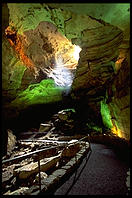 Keep going southeast until you
get to Carlsbad Caverns, where just one room is the size of 14 football fields.
Go 26 miles east to the Waste Isolation Pilot Project (tours MWF, (800)
336-WIPP). Some of the synthetic byproducts of atomic weapons remain deadly for
100,000 years. You'll be comforted to know that WIPP is designed to be stable for
10,000 years.
Keep going southeast until you
get to Carlsbad Caverns, where just one room is the size of 14 football fields.
Go 26 miles east to the Waste Isolation Pilot Project (tours MWF, (800)
336-WIPP). Some of the synthetic byproducts of atomic weapons remain deadly for
100,000 years. You'll be comforted to know that WIPP is designed to be stable for
10,000 years.
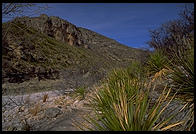 Drive through Guadalupe Mountains
National Park into El Paso. Reflect on the old saying that "Phoenix is a bad
imitation of L.A.; Albuquerque is a bad imitation of Phoenix; El Paso is a bad
imitation of Albuquerque." Walk across the border to savor the surprisingly
European character of Juarez, Mexico before proceeding west on I-10 to Tucson,
Arizona, the former home of 54 Titan ICBMs. One of the silos, in Green Valley, a
retirement community 25 miles south of Tucson, has been turned into a museum.
Drive through Guadalupe Mountains
National Park into El Paso. Reflect on the old saying that "Phoenix is a bad
imitation of L.A.; Albuquerque is a bad imitation of Phoenix; El Paso is a bad
imitation of Albuquerque." Walk across the border to savor the surprisingly
European character of Juarez, Mexico before proceeding west on I-10 to Tucson,
Arizona, the former home of 54 Titan ICBMs. One of the silos, in Green Valley, a
retirement community 25 miles south of Tucson, has been turned into a museum.
Head for Las Vegas, starting point for tours of the Nevada Test Site. You have to admire a government with enough sense of humor to label a nuclear bomb detonation site an "Environmental Research Park." Tours last all day but are only given once/month (call (702) 295-0944 to reserve). Due to the radiation hazard, a sign warns you not to make off with any "fused silica" or "blasted debris." While waiting for the tour, check out the nearby Hoover Dam and the Kidd's marshmallow factory tour in Henderson.
Lawrence Livermore National Laboratory, just east of San Francisco, figured prominently in the development of the H-bomb and Star Wars. Short tours are Monday at 1 pm and long ones are the third Thursday of every month. Either way you'll see the world's largest laser (call (510) 422-4599 two weeks in advance).
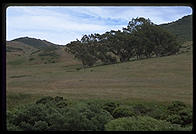 Drive over the Golden
Gate Bridge into Marin County, famed home of hot tub hedonism and... Nike air
defense missiles with nuclear warheads. The site is open on the first Sunday of
every month from 12:30 to 3:30 (call (415) 331-1540). If you think the shopping
in Sausilito is a little too frou-frou, go a little farther up the Bay to the San
Quentin Prison museum and handicraft shop (closed on Sundays; (415)
454-8808).
Drive over the Golden
Gate Bridge into Marin County, famed home of hot tub hedonism and... Nike air
defense missiles with nuclear warheads. The site is open on the first Sunday of
every month from 12:30 to 3:30 (call (415) 331-1540). If you think the shopping
in Sausilito is a little too frou-frou, go a little farther up the Bay to the San
Quentin Prison museum and handicraft shop (closed on Sundays; (415)
454-8808).
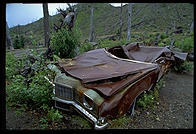 Continue up the coast and then inland on Washington State Route 503 towards
Mt. St. Helens. Stop along the way on the shores of Lake Merwin in Ariel, the
legendary 1971 landing spot of D.B. Cooper. Cooper parachuted out of the
Northwest Airlines flight that he'd hijacked with $200,000 in cash. Locals heard
a light plane land and take off, the last that was ever heard of Mr. Cooper.
Continue through the St. Helens wasteland and into Mt. Rainier National Park.
Follow SR 410 east to I-82 and keep going until you get to Richland, home of the
Hanford Reservation. Hanford produced the plutonium for the Trinity and Nagasaki
bombs. Today the main activity at Hanford is spending $billions containing and
cleaning up millions of gallons of radioactive waste water. The town contains a
nuclear energy museum and a demonstration nuclear plant.
Continue up the coast and then inland on Washington State Route 503 towards
Mt. St. Helens. Stop along the way on the shores of Lake Merwin in Ariel, the
legendary 1971 landing spot of D.B. Cooper. Cooper parachuted out of the
Northwest Airlines flight that he'd hijacked with $200,000 in cash. Locals heard
a light plane land and take off, the last that was ever heard of Mr. Cooper.
Continue through the St. Helens wasteland and into Mt. Rainier National Park.
Follow SR 410 east to I-82 and keep going until you get to Richland, home of the
Hanford Reservation. Hanford produced the plutonium for the Trinity and Nagasaki
bombs. Today the main activity at Hanford is spending $billions containing and
cleaning up millions of gallons of radioactive waste water. The town contains a
nuclear energy museum and a demonstration nuclear plant.
Head west to Everett, Washington (25 miles north of Seattle) and finish your trip at the Boeing 747 factory, the world's largest building (9 and 1 M-F; (206) 342-4801).
If you are actually planning to take this trip, you may wish to look at the user-contributed Related Links page.
Return
to the Great Trips index page
Text and pictures copyright 1993-1996 Philip Greenspun